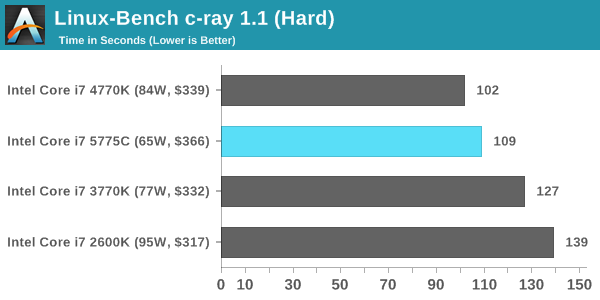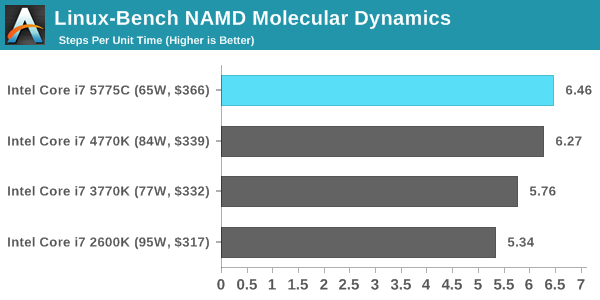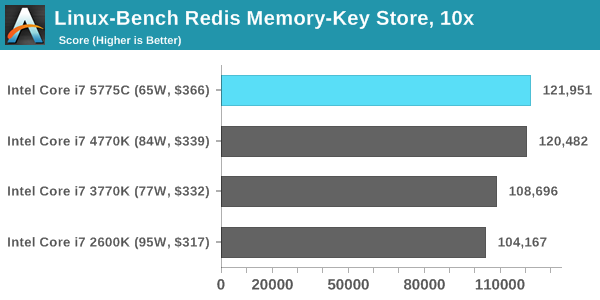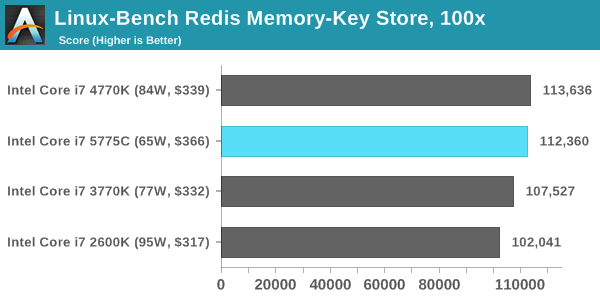The Intel Broadwell Review Part 2: Overclocking, IPC and Generational Analysis
by Ian Cutress on August 3, 2015 8:00 AM ESTLinux Performance
Built around several freely available benchmarks for Linux, Linux-Bench is a project spearheaded by Patrick at ServeTheHome to streamline about a dozen of these tests in a single neat package run via a set of three commands using an Ubuntu 11.04 LiveCD. These tests include fluid dynamics used by NASA, ray-tracing, OpenSSL, molecular modeling, and a scalable data structure server for web deployments. We run Linux-Bench and have chosen to report a select few of the tests that rely on CPU and DRAM speed.
C-Ray: link
C-Ray is a simple ray-tracing program that focuses almost exclusively on processor performance rather than DRAM access. The test in Linux-Bench renders a heavy complex scene offering a large scalable scenario.

NAMD, Scalable Molecular Dynamics: link
Developed by the Theoretical and Computational Biophysics Group at the University of Illinois at Urbana-Champaign, NAMD is a set of parallel molecular dynamics codes for extreme parallelization up to and beyond 200,000 cores. The reference paper detailing NAMD has over 4000 citations, and our testing runs a small simulation where the calculation steps per unit time is the output vector.

NPB, Fluid Dynamics: link
Aside from LINPACK, there are many other ways to benchmark supercomputers in terms of how effective they are for various types of mathematical processes. The NAS Parallel Benchmarks (NPB) are a set of small programs originally designed for NASA to test their supercomputers in terms of fluid dynamics simulations, useful for airflow reactions and design.

Redis: link
Many of the online applications rely on key-value caches and data structure servers to operate. Redis is an open-source, scalable web technology with a b developer base, but also relies heavily on memory bandwidth as well as CPU performance.













121 Comments
View All Comments
Pino - Monday, August 3, 2015 - link
Looks like my i7 3770 will live longer.icebox - Monday, August 3, 2015 - link
I'm really curious how the Skylake i7 will present itself in exactly this comparison article. I, like many am still on a 2600k and pondering an upgrade to either haswell-e or skylake.blaktron - Monday, August 3, 2015 - link
Me too. I run my 2600k at 4.5 ghz on air with no stability issues ever and by the looks of it, 4 years later, I'm STILL looking at a lateral upgrade. Skylake better at least add some OC headroom back along with its 15% or this might be the first gaming PC i have that dies of old age...lilmoe - Monday, August 3, 2015 - link
I'd wait it out if I were you. The 2600K is absolutely no slouch, and you'll probably be disappointed after spending lots of cash on Haswell-E. The only thing going for these newer chips are peripherals, so it's all about your priorities.HollyDOL - Monday, August 3, 2015 - link
2500k at 4.3GHz here, still no pressurre for upgrades. Not that I'd complain :-)HollyDOL - Monday, August 3, 2015 - link
pressure*where is the [edit]?
faizoff - Monday, August 3, 2015 - link
Yup same here, OC'ed my 2500K to 4.6 Ghz on air and have had the same build for over 4 years now. Still excellent performance and the only regret I have is not getting the 2600K at the time. I've started to delve greatly into developing and server VMs locally so that would've been a great setup.Kevin G - Monday, August 3, 2015 - link
I'm in a similar boot with a 2600K but I also have a Sandy Bridge-E 3930k. So far I'm not feeling any pressure to upgrade from on the processor side for either chip.For me, the most attractive thing about Skylake is the chipset which adds 20 PCIe lanes on top of the 16 from the CPU. This should enable some motherboards to stack on features without compromising dual GPU scenarios and even enable triple GPU setups with all 8x links. (There is enough lanes to do quad GPUs but DMI would be too much of a bottleneck for two cards + IO.)
Haswell-E on the other hand just doesn't interest me at all. The low end 5820K is a cheap 6 core part but has the reduced PCIe lane count. In many regards, SkyLake with Z170 would be the better option than a 5820K setup. Going to the 5930K improves IO but the price premium just isn't worth it. Thankfully Broadwell-E should be arriving at the very end of this year/early next year so hopefully Intel can revive the X99 platform.
Mr Perfect - Monday, August 3, 2015 - link
Yes, thanks for including the 2600 in this. Mine has been doing well, and with DX12 reducing CPU dependance in the future, it's probably going to be relevant for some time. It's nice to see what an upgrade will actually be worth.Sttm - Monday, August 3, 2015 - link
Heh me too. 2600k OC'd to 4.5 ghz going on over 4 years now. Which is just crazy because before that I upgraded CPU every 2 -3 years. But now it seems Intel does not care about performance, just power/performance, and AMD is a clusterduck.